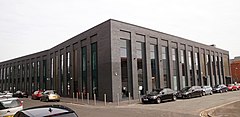Birmingham Assay Office
| Birmingham Assay Office (1877) | |
|---|---|
 |
|
| General information | |
| Type | Assay Office |
| Architectural style | Victorian Italianate |
| Address | Newhall Street |
| Town or city | Birmingham |
| Country | England |
| Coordinates | 52°29′02″N 1°54′22″W / 52.48389°N 1.90611°WCoordinates: 52°29′02″N 1°54′22″W / 52.48389°N 1.90611°W |
| Completed | 1877 (Phipson), 1890, 1899, 1907, 1914 (Ewen Harper, architect), 1974 |
| Relocated | 27 July 2015 |
| Owner | TCN UK |
| Design and construction | |
| Architect | Andrew Phipson |
|
Listed Building – Grade II
|
|
| Designated | 25 September 1972 |
| Reference no. | 1076142 |
| Assay Office Birmingham (new site 2015) | |
|---|---|
 |
|
| General information | |
| Type | Assay Office |
| Address | 1 Moreton Street |
| Town or city | Birmingham |
| Country | England |
| Coordinates | 52°29′11″N 1°55′03″W / 52.4864°N 1.9176°W |
| Completed | 2015 |
| Opened | 27 July 2015 |
The Birmingham Assay Office, one of the four assay offices in the United Kingdom, is located in the Jewellery Quarter, Birmingham. The development of a silver industry in 18th century Birmingham was hampered by the legal requirement that items of solid silver be assayed, and the nearest Assay Offices were in Chester and London.Matthew Boulton and Birmingham's other great industrialists joined forces with silversmiths of Sheffield to petition Parliament for the establishment of Assay Offices in their respective cities. In spite of determined opposition by London silversmiths, an Act of Parliament was passed in March 1773, just one month after the original petition was presented to Parliament, to allow Birmingham and Sheffield the right to assay silver. The Birmingham Assay Office opened on 31 August 1773 and initially operated from three rooms in the King's Head Inn on New Street employing only four staff and was only operating on a Tuesday. The first customer on that day was Matthew Boulton.
The assay office is managed by a board of 36 "Guardians of the Standard of Wrought Plate in Birmingham", between six and nine of whom must be connected with the trade.
The hallmark of the Birmingham Assay Office is the Anchor, and that of the Sheffield Assay Office was the Crown. A story about the origins of this hallmark goes that meetings prior to the inauguration of both Birmingham and Sheffield Assay Offices in 1773 were held at a public house called the Crown and Anchor Tavern on the Strand, London. It is rumoured that the choice of symbol was made on the toss of a coin which resulted in Birmingham winning the Anchor and Sheffield with the Crown (which has now been changed to a rose).
...
Wikipedia
